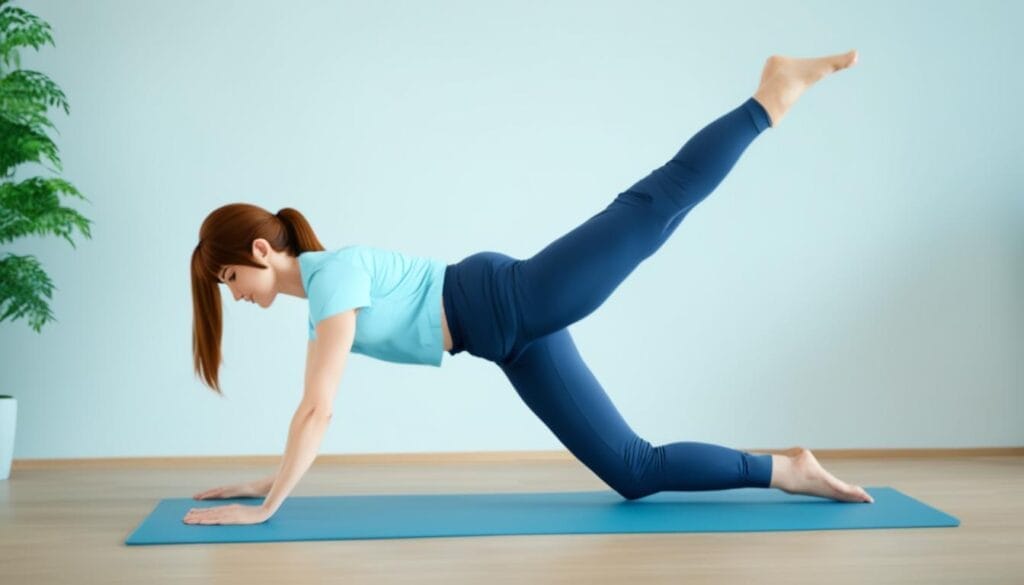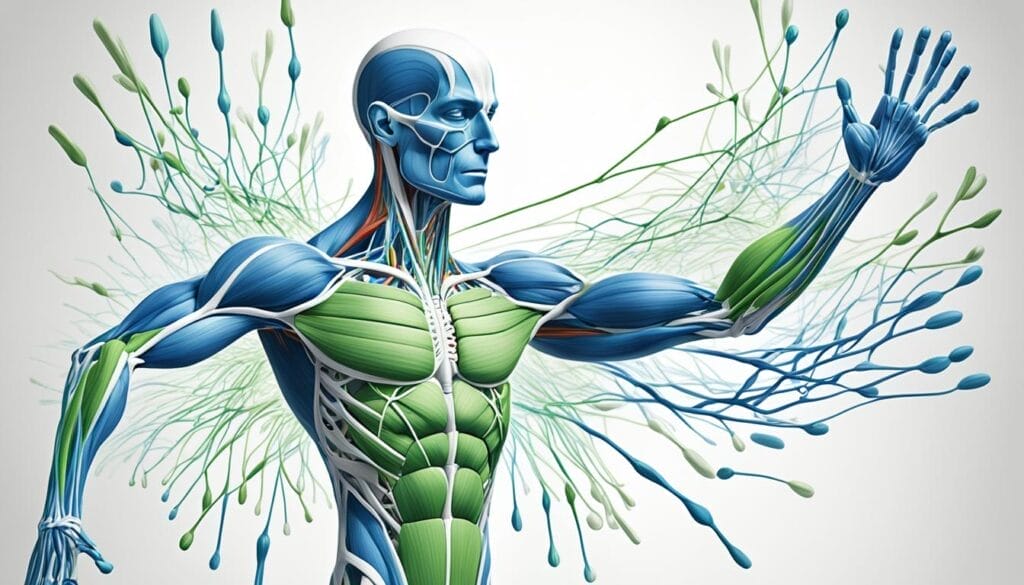Ever felt like you just can’t move as freely as you want to? Wish you could bend and twist without stiffness holding you back? I get it. And I’ve got something to share that might just make a big difference for you. It’s called Proprioceptive Neuromuscular Facilitation (PNF) stretching. This technique can open up a world of easier movement for you.
PNF stretching is far from ordinary. It’s an active and specific way to boost how far you can move. This is great for athletes needing to up their game or if you’re trying to bounce back from an injury. Neurophysiologist Herman Kabat and physical therapist Maggie Knott first came up with this method. It was meant for therapy but is now used by many, not just athletes, for better movement.
Ready to get super flexible? Let’s get into PNF stretching together. We’ll go over tips, rules, and how to be safe when trying this amazing stretching method.
Key Takeaways:
- Proprioceptive Neuromuscular Facilitation (PNF) stretching can significantly improve your range of motion and flexibility.
- PNF stretching was originally developed for therapeutic purposes but has been adapted for athletic performance enhancement.
- There are three main PNF methods: contract-relax, contract-relax-antagonist-contract, and hold-relax-swing.
- PNF stretching can boost performance in exercises like jogging but may decrease performance for high-intensity exercises like weight-lifting and sprinting.
- It’s important to consult a professional or trainer when starting with PNF stretching to ensure proper technique and avoid injury.
What is PNF Stretching and How Does it Work?
PNF stretching is a technique that improves flexibility by using our body’s reflexes. Dr. Herman Kabat came up with it during the 1940s to help his patients with muscle and nerve conditions.
This method works with a reflex that makes your muscle relax to avoid harm. It makes stretching safer and more helpful.
There are a few ways to do PNF stretching, each helping with different muscles. Let’s look at some of these ways:
- The hold-relax technique, where a muscle is stretched, then briefly tensed, and then relaxed. After relaxing, the muscle is stretched again.
- The contract-relax technique, where the muscle is stretched and then gently tensed to enhance the stretch.
- The hold-relax-contract technique, which combines both, making the stretch even deeper.
These ways are great for working on many body muscles. They can be used alone or with someone else, depending on what you want to achieve.
The picture above shows how PNF stretching is done. It includes stretching, tensing, and then relaxing your muscles. This helps you stretch them deeper.
The Benefits of PNF Stretching
PNF stretching is great for your overall physical health and flexibility. Adding it to your workouts can make your joints move better, your body more bendy, and your muscles stronger.
It’s known for really boosting how far your joints can move. Studies say it’s the best way to make your body more flexible. With regular PNF stretching, you’ll find you can touch your toes or reach for the stars.
This stretching type works wonders for the back of your legs and calves. It makes them not so tight and helps stop you from getting hurt when you’re active.
Plus, it makes your muscles stronger, too. Stretching and tensing them up this way gets them working hard. This makes PNF stretching a good partner for weightlifting, giving you stronger muscles all over.
Athletes can get a big boost from PNF stretching. It’s been proven to make them jump higher and throw further. More movement and flexibility mean better sports performance all around.
So, if you want to be more flexible, stronger, or perform better in sports, try PNF stretching. It’s a simple but powerful tool for improving your fitness.

“Incorporating PNF stretching into your exercise routine can lead to increased range of motion, improved flexibility, and increased muscle strength.”
How to Start with PNF Stretching
If you’re starting with PNF stretching, talking to a pro or a trainer is wise. They can teach you the right move and avoid injury. You can focus stretching on just one area or aim for all-round flexibility.
To zero in on certain zones, seeing a physical therapist skilled in PNF helps. They design a custom program for your specific needs. You’ll work on stretching side fascia, hip flexors, hamstrings, glutes, and back. This addresses any limited mobility or trouble spots.
Want to boost overall flexibility? Add easy PNF stretches to your day. Start with simple moves for key muscles. Then, move up to tougher techniques. This will better your mobility and flexibility over time.
Basic PNF Stretching Techniques for General Flexibility Improvement
- Hamstring Stretch: Lie on your back with one leg straight up in the air. Use a strap or towel to hold your foot and gently pull it towards you until you feel a stretch. Hold for a few seconds, then release and repeat.
- Quad Stretch: Stand tall and hold onto a support if needed. Bend one knee and grab your ankle behind you. Pull your ankle towards your buttocks to feel a stretch in the front of your thigh. Hold for a few seconds, then release and repeat on the other leg.
- Chest Stretch: Stand or sit upright with your arms extended out to the sides. Clasp your hands behind your back and squeeze your shoulder blades together. Hold for a few seconds, then release and repeat.
- Side Stretch: Stand with your feet shoulder-width apart. Raise one arm overhead and slowly lean to the opposite side, feeling a stretch along the side of your body. Hold for a few seconds, then return to the starting position and repeat on the other side.
“Remember to always breathe through the stretches and use calming thoughts to avoid tightening up. Keep it simple and remember the key steps: contract, relax, breathe, and stretch.”
Doing these stretches often will boost your flexibility. Remember, let your body guide you, stretch only as far as feels good, and don’t push through pain. As you get more flexible, you can up the challenge of your stretches. Enjoy the journey and feel the positive changes in your body with PNF stretching.
| Benefits of Starting PNF Stretching | Starting PNF Stretching Techniques |
|---|---|
| Improves flexibility | Hamstring stretch |
| Increases range of motion | Quad stretch |
| Enhances muscle strength | Chest stretch |
| Aids in injury prevention | Side stretch |
Safety Precautions for PNF Stretching
PNF stretching is very beneficial but it must be done safely. Safety should always come first. To do these stretches correctly and avoid injuries, it’s best to get advice from a pro.
If you’re new to PNF or don’t know the right way, talking to a trained expert is smart. They can teach you the right form and how to do the stretches without harm.
When it comes to age, PNF stretching isn’t for under 18s. Young people’s bodies are still growing. They can easily get hurt while stretching this way. If you’re not sure, talking to a doctor or fitness expert first is wise.
Following these safety tips and getting expert advice can make PNF stretching much safer. It helps you get all the good without the bad.
The Science Behind PNF Stretching
PNF stretching works in the body thanks to several key processes. These help us understand how this technique boosts flexibility, range of motion, and performance in sports.
Autogenic Inhibition
Autogenic inhibition is important in PNF stretching. It comes into play when a stretched muscle tightens. This tightening sends signals for the muscle to relax. This results in a deeper stretch and more flexibility.
Reciprocal Inhibition
Reciprocal inhibition is another key part. Here, the muscle opposite to the one being stretched tightens. This helps the target muscle relax, improving flexibility.
Stress Relaxation
Stress relaxation happens as a muscle is slowly stretched. The steady stretch lets the muscle adapt and relax in its new, longer state. This increases flexibility and range of motion.
Gate Control Theory
The gate control theory explains another benefit. PNF stretching is thought to reduce how much we feel pain by ‘closing the gate’ to pain signals. This happens as we engage our muscles with PNF techniques, possibly making stretching less painful and more effective.
These methods of PNF stretching work together to make us more flexible. They also strengthen our muscles and boost our sports performance. Knowing the science of stretching helps us use it wisely in our workout plans.

| Physiological Mechanisms | Effect on Stretching |
|---|---|
| Autogenic Inhibition | Causes muscle relaxation, allowing for a deeper stretch |
| Reciprocal Inhibition | Relaxes the target muscle by contracting the antagonist muscle |
| Stress Relaxation | Gradually relaxes the muscle over time, improving flexibility |
| Gate Control Theory | Reduces pain sensation, making stretching more comfortable |
Summing It Up
PNF stretching boosts flexibility and range of motion effectively. It helps with muscle strength and makes you better at sports. Always make sure to stay safe and get advice if you’re new to it.
PNF stretching really improves how much you can move and how flexible you are. It’s great for athletes and anyone who wants to move better. Add it to your exercise plan for maximum benefit.
When doing these stretches, be careful and know your limits. Getting guidance from a pro or a trainer is key. Safety and the right technique are important for seeing the best results in your fitness.
FAQ
What is PNF stretching?
PNF stretching stands for proprioceptive neuromuscular facilitation. It’s a method to boost how much your joints can move and how flexible your muscles are. It uses reflexes to let your muscles stretch more deeply.
How does PNF stretching work?
It works by making your muscle stretch, then contract, and finally relax. This cycle is repeated. It uses methods like holding a stretch, contracting the muscle, then relaxing and stretching it further.
What are the benefits of PNF stretching?
PNF stretching can make you more flexible and extend your range of motion. This technique also helps with conditioning for sports, such as improving your ability to jump and throw things.
How do I start with PNF stretching?
If you’re new to it, getting advice from a pro or a trainer is wise. They’ll show you how to do it right. To get generally more flexible, concentrate on stretching the side fascia, hip flexors, hamstrings, glutes, and your back.
What safety precautions should I follow when doing PNF stretching?
It’s important to get professional advice, especially if you’re just starting. Those under 18 should not do PNF stretching unless a doctor or fitness pro says it’s okay. Always check with a healthcare expert before starting any new exercise.
What is the science behind PNF stretching?
The science of PNF stretching uses things like relaxing stress and controlling the brain’s response. These mechanisms help you stretch further, making your muscles more flexible and boosting how well you can perform in sports.
Source Links
Share Me:
READY TO UNLEASH
YOUR BEST SELF?
Click “Sign Me Up!” And Start Your Fitness Transformation!





